Saurabh Gupta
AlphaOne: Reasoning Models Thinking Slow and Fast at Test Time
May 30, 2025Abstract:This paper presents AlphaOne ($\alpha$1), a universal framework for modulating reasoning progress in large reasoning models (LRMs) at test time. $\alpha$1 first introduces $\alpha$ moment, which represents the scaled thinking phase with a universal parameter $\alpha$. Within this scaled pre-$\alpha$ moment phase, it dynamically schedules slow thinking transitions by modeling the insertion of reasoning transition tokens as a Bernoulli stochastic process. After the $\alpha$ moment, $\alpha$1 deterministically terminates slow thinking with the end-of-thinking token, thereby fostering fast reasoning and efficient answer generation. This approach unifies and generalizes existing monotonic scaling methods by enabling flexible and dense slow-to-fast reasoning modulation. Extensive empirical studies on various challenging benchmarks across mathematical, coding, and scientific domains demonstrate $\alpha$1's superior reasoning capability and efficiency. Project page: https://alphaone-project.github.io/
How Do I Do That? Synthesizing 3D Hand Motion and Contacts for Everyday Interactions
Apr 16, 2025



Abstract:We tackle the novel problem of predicting 3D hand motion and contact maps (or Interaction Trajectories) given a single RGB view, action text, and a 3D contact point on the object as input. Our approach consists of (1) Interaction Codebook: a VQVAE model to learn a latent codebook of hand poses and contact points, effectively tokenizing interaction trajectories, (2) Interaction Predictor: a transformer-decoder module to predict the interaction trajectory from test time inputs by using an indexer module to retrieve a latent affordance from the learned codebook. To train our model, we develop a data engine that extracts 3D hand poses and contact trajectories from the diverse HoloAssist dataset. We evaluate our model on a benchmark that is 2.5-10X larger than existing works, in terms of diversity of objects and interactions observed, and test for generalization of the model across object categories, action categories, tasks, and scenes. Experimental results show the effectiveness of our approach over transformer & diffusion baselines across all settings.
3D Object Reconstruction with mmWave Radars
Apr 15, 2025Abstract:This paper presents RFconstruct, a framework that enables 3D shape reconstruction using commercial off-the-shelf (COTS) mmWave radars for self-driving scenarios. RFconstruct overcomes radar limitations of low angular resolution, specularity, and sparsity in radar point clouds through a holistic system design that addresses hardware, data processing, and machine learning challenges. The first step is fusing data captured by two radar devices that image orthogonal planes, then performing odometry-aware temporal fusion to generate denser 3D point clouds. RFconstruct then reconstructs 3D shapes of objects using a customized encoder-decoder model that does not require prior knowledge of the object's bound box. The shape reconstruction performance of RFconstruct is compared against 3D models extracted from a depth camera equipped with a LiDAR. We show that RFconstruct can accurately generate 3D shapes of cars, bikes, and pedestrians.
PhysGen3D: Crafting a Miniature Interactive World from a Single Image
Mar 26, 2025Abstract:Envisioning physically plausible outcomes from a single image requires a deep understanding of the world's dynamics. To address this, we introduce PhysGen3D, a novel framework that transforms a single image into an amodal, camera-centric, interactive 3D scene. By combining advanced image-based geometric and semantic understanding with physics-based simulation, PhysGen3D creates an interactive 3D world from a static image, enabling us to "imagine" and simulate future scenarios based on user input. At its core, PhysGen3D estimates 3D shapes, poses, physical and lighting properties of objects, thereby capturing essential physical attributes that drive realistic object interactions. This framework allows users to specify precise initial conditions, such as object speed or material properties, for enhanced control over generated video outcomes. We evaluate PhysGen3D's performance against closed-source state-of-the-art (SOTA) image-to-video models, including Pika, Kling, and Gen-3, showing PhysGen3D's capacity to generate videos with realistic physics while offering greater flexibility and fine-grained control. Our results show that PhysGen3D achieves a unique balance of photorealism, physical plausibility, and user-driven interactivity, opening new possibilities for generating dynamic, physics-grounded video from an image.
KISS-SLAM: A Simple, Robust, and Accurate 3D LiDAR SLAM System With Enhanced Generalization Capabilities
Mar 16, 2025Abstract:Robust and accurate localization and mapping of an environment using laser scanners, so-called LiDAR SLAM, is essential to many robotic applications. Early 3D LiDAR SLAM methods often exploited additional information from IMU or GNSS sensors to enhance localization accuracy and mitigate drift. Later, advanced systems further improved the estimation at the cost of a higher runtime and complexity. This paper explores the limits of what can be achieved with a LiDAR-only SLAM approach while following the "Keep It Small and Simple" (KISS) principle. By leveraging this minimalistic design principle, our system, KISS-SLAM, archives state-of-the-art performances in pose accuracy while requiring little to no parameter tuning for deployment across diverse environments, sensors, and motion profiles. We follow best practices in graph-based SLAM and build upon LiDAR odometry to compute the relative motion between scans and construct local maps of the environment. To correct drift, we match local maps and optimize the trajectory in a pose graph optimization step. The experimental results demonstrate that this design achieves competitive performance while reducing complexity and reliance on additional sensor modalities. By prioritizing simplicity, this work provides a new strong baseline for LiDAR-only SLAM and a high-performing starting point for future research. Further, our pipeline builds consistent maps that can be used directly for further downstream tasks like navigation. Our open-source system operates faster than the sensor frame rate in all presented datasets and is designed for real-world scenarios.
A Training-Free Framework for Precise Mobile Manipulation of Small Everyday Objects
Feb 19, 2025Abstract:Many everyday mobile manipulation tasks require precise interaction with small objects, such as grasping a knob to open a cabinet or pressing a light switch. In this paper, we develop Servoing with Vision Models (SVM), a closed-loop training-free framework that enables a mobile manipulator to tackle such precise tasks involving the manipulation of small objects. SVM employs an RGB-D wrist camera and uses visual servoing for control. Our novelty lies in the use of state-of-the-art vision models to reliably compute 3D targets from the wrist image for diverse tasks and under occlusion due to the end-effector. To mitigate occlusion artifacts, we employ vision models to out-paint the end-effector thereby significantly enhancing target localization. We demonstrate that aided by out-painting methods, open-vocabulary object detectors can serve as a drop-in module to identify semantic targets (e.g. knobs) and point tracking methods can reliably track interaction sites indicated by user clicks. This training-free method obtains an 85% zero-shot success rate on manipulating unseen objects in novel environments in the real world, outperforming an open-loop control method and an imitation learning baseline trained on 1000+ demonstrations by an absolute success rate of 50%.
Learning Getting-Up Policies for Real-World Humanoid Robots
Feb 17, 2025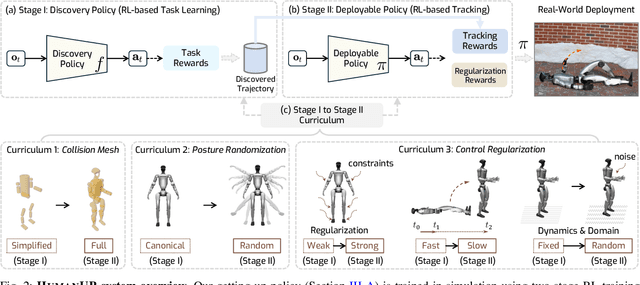
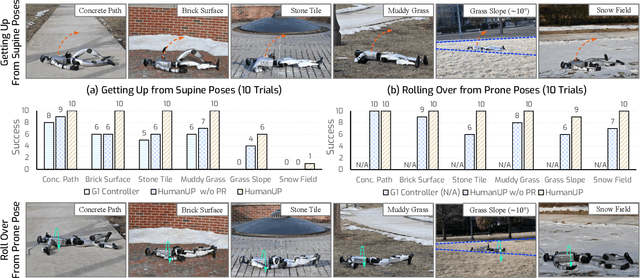
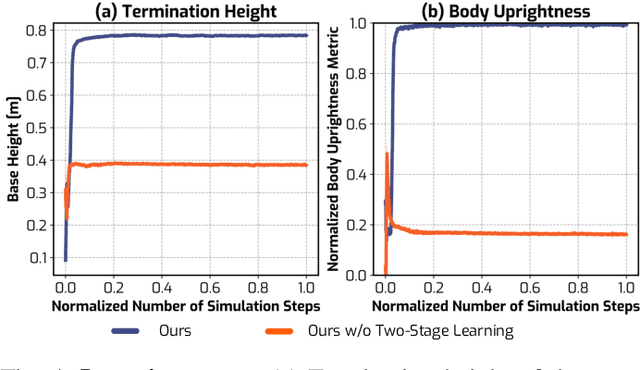
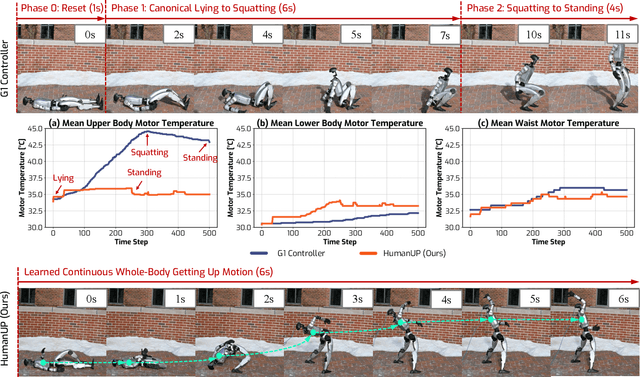
Abstract:Automatic fall recovery is a crucial prerequisite before humanoid robots can be reliably deployed. Hand-designing controllers for getting up is difficult because of the varied configurations a humanoid can end up in after a fall and the challenging terrains humanoid robots are expected to operate on. This paper develops a learning framework to produce controllers that enable humanoid robots to get up from varying configurations on varying terrains. Unlike previous successful applications of humanoid locomotion learning, the getting-up task involves complex contact patterns, which necessitates accurately modeling the collision geometry and sparser rewards. We address these challenges through a two-phase approach that follows a curriculum. The first stage focuses on discovering a good getting-up trajectory under minimal constraints on smoothness or speed / torque limits. The second stage then refines the discovered motions into deployable (i.e. smooth and slow) motions that are robust to variations in initial configuration and terrains. We find these innovations enable a real-world G1 humanoid robot to get up from two main situations that we considered: a) lying face up and b) lying face down, both tested on flat, deformable, slippery surfaces and slopes (e.g., sloppy grass and snowfield). To the best of our knowledge, this is the first successful demonstration of learned getting-up policies for human-sized humanoid robots in the real world. Project page: https://humanoid-getup.github.io/
Efficiently Closing Loops in LiDAR-Based SLAM Using Point Cloud Density Maps
Jan 13, 2025



Abstract:Consistent maps are key for most autonomous mobile robots. They often use SLAM approaches to build such maps. Loop closures via place recognition help maintain accurate pose estimates by mitigating global drift. This paper presents a robust loop closure detection pipeline for outdoor SLAM with LiDAR-equipped robots. The method handles various LiDAR sensors with different scanning patterns, field of views and resolutions. It generates local maps from LiDAR scans and aligns them using a ground alignment module to handle both planar and non-planar motion of the LiDAR, ensuring applicability across platforms. The method uses density-preserving bird's eye view projections of these local maps and extracts ORB feature descriptors from them for place recognition. It stores the feature descriptors in a binary search tree for efficient retrieval, and self-similarity pruning addresses perceptual aliasing in repetitive environments. Extensive experiments on public and self-recorded datasets demonstrate accurate loop closure detection, long-term localization, and cross-platform multi-map alignment, agnostic to the LiDAR scanning patterns, fields of view, and motion profiles.
Efficient LiDAR Bundle Adjustment for Multi-Scan Alignment Utilizing Continuous-Time Trajectories
Dec 16, 2024Abstract:Constructing precise global maps is a key task in robotics and is required for localization, surveying, monitoring, or constructing digital twins. To build accurate maps, data from mobile 3D LiDAR sensors is often used. Mapping requires correctly aligning the individual point clouds to each other to obtain a globally consistent map. In this paper, we investigate the problem of multi-scan alignment to obtain globally consistent point cloud maps. We propose a 3D LiDAR bundle adjustment approach to solve the global alignment problem and jointly optimize the available data. Utilizing a continuous-time trajectory allows us to consider the ego-motion of the LiDAR scanner while recording a single scan directly in the least squares adjustment. Furthermore, pruning the search space of correspondences and utilizing out-of-core circular buffer enables our approach to align thousands of point clouds efficiently. We successfully align point clouds recorded with a handheld LiDAR, as well as ones mounted on a vehicle, and are able to perform multi-session alignment.
Learning Smooth Humanoid Locomotion through Lipschitz-Constrained Policies
Oct 15, 2024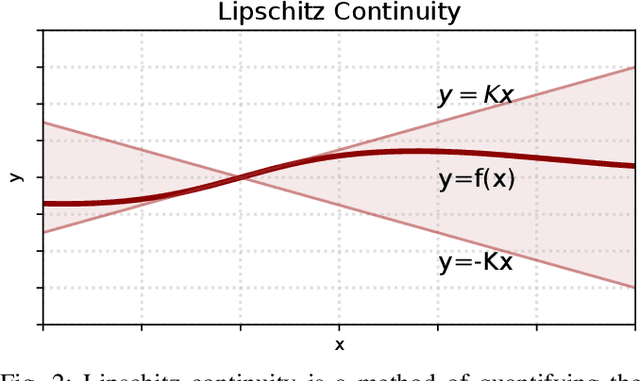
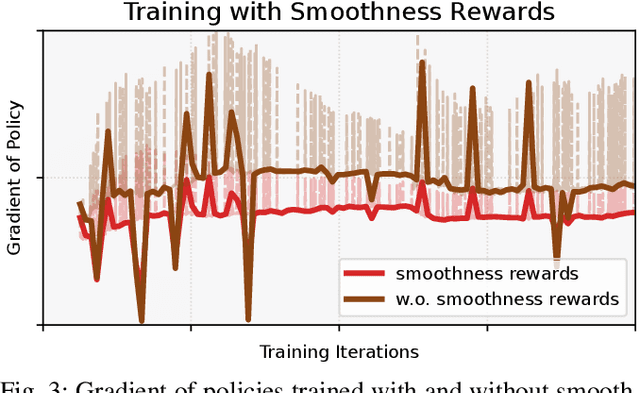

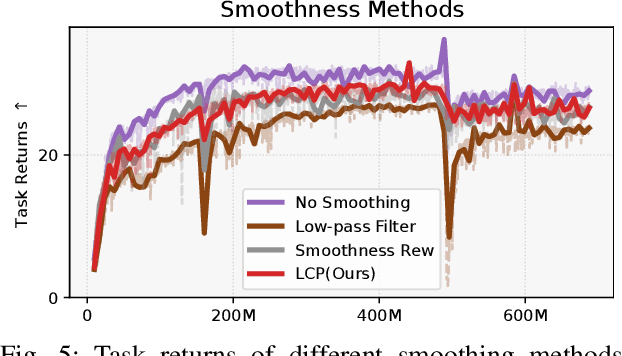
Abstract:Reinforcement learning combined with sim-to-real transfer offers a general framework for developing locomotion controllers for legged robots. To facilitate successful deployment in the real world, smoothing techniques, such as low-pass filters and smoothness rewards, are often employed to develop policies with smooth behaviors. However, because these techniques are non-differentiable and usually require tedious tuning of a large set of hyperparameters, they tend to require extensive manual tuning for each robotic platform. To address this challenge and establish a general technique for enforcing smooth behaviors, we propose a simple and effective method that imposes a Lipschitz constraint on a learned policy, which we refer to as Lipschitz-Constrained Policies (LCP). We show that the Lipschitz constraint can be implemented in the form of a gradient penalty, which provides a differentiable objective that can be easily incorporated with automatic differentiation frameworks. We demonstrate that LCP effectively replaces the need for smoothing rewards or low-pass filters and can be easily integrated into training frameworks for many distinct humanoid robots. We extensively evaluate LCP in both simulation and real-world humanoid robots, producing smooth and robust locomotion controllers. All simulation and deployment code, along with complete checkpoints, is available on our project page: https://lipschitz-constrained-policy.github.io.
 Add to Chrome
Add to Chrome Add to Firefox
Add to Firefox Add to Edge
Add to Edge